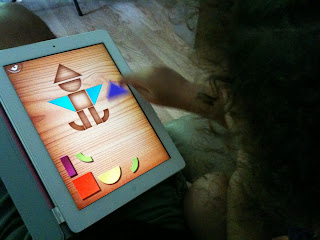
Throughout the month of June, my daughter and I have been “learning” to use the iPad together. She looks forward to the time we spend using it. Every time I take out the iPad, she is eager to take part. These are some of my thoughts and impressions as we began exploring the iPad through a variety of math apps.
Having a decent amount of experience with the iOS platform I was, at first, more interested in how my daughter would interact with the touch screen of the iPad. I wondered if it would be difficult for someone developing her fine motor skills to move objects around without the tactile feedback we receive when we “touch” something. For the most part, she adapted to the nature of the iPad very quickly.
The interactions she has had so far have involved two types of “touch” – tapping and dragging. “Tapping” came easily as it almost always provides immediate feedback. You tap a spot and something happens or nothing happens. All she needed to know was where to tap. Most of the apps we have explored so far have involved tapping. She generally took to these games quickly and was able to work on her own with little support from me.
“Dragging” is a more challenging task, as objects have to be moved to a particular “spot” for the desired result to take affect. It took her a little while to get adjusted to touching an object and moving it, especially when the object was smaller. She only had visual clues to gauge whether she had “grasped” the object she intended and initially experienced some frustration when she wasn’t able to interact with the game in the way she wanted. Pieces would move to the wrong place or not move at all. Also, she seemed to find it particularly frustrating when she dragged something to where she thought she was supposed to, but her placement was “off” just enough for the app to ask her to try again. She needed more support from me until she gained enough confidence to work on her own.
One other challenge for small children working with the iPad is the devices expectation that you touch it only in one spot. Many times early in our experiences together, my daughter would try to make something happen on the screen and could not get the iPad to respond as she was touching the screen with her palm pad or wrist already. I had to help her position her hand in such a way that only her finger touched the screen. This is similar to the conundrum faced by children and adults using a SMARTBoard.
In working with some of the “learning” apps (my impressions of them will come in a later post), I was not surprised to find that the more “teaching” it was (in her opinion, Numerate and Intro to Math), the less time my daughter would work with it. She would ask to "play" something else. With more frequent breaks, she would return to these apps but it was clear they were not her favorites. The more game/puzzle oriented it was, (Number Sense HD and Park Math HD were favorites), the longer she would interact with the app. She was more likely to request these apps the next time we sat down together. She would talk about playing these apps and about how much fun they were.
The biggest benefit for me in sitting down with my daughter and the iPad is the information I got about her understanding of number so far. I found that even some of the weaker apps still gave me insight about how she thinks when counting and making groups. I can see in the classroom these apps providing feedback that could be used to develop subsequent instruction and classroom experiences.
The video encapsulates our experiences with the iPad thus far. She can hold her hand so that only her finger touch the screen, sometimes makes multiple attempts to move small objects to where she wants them, is fairly accurate and careful in her counting (one-to one), counting above twenty is something she is still learning; she is having fun.
No comments:
Post a Comment